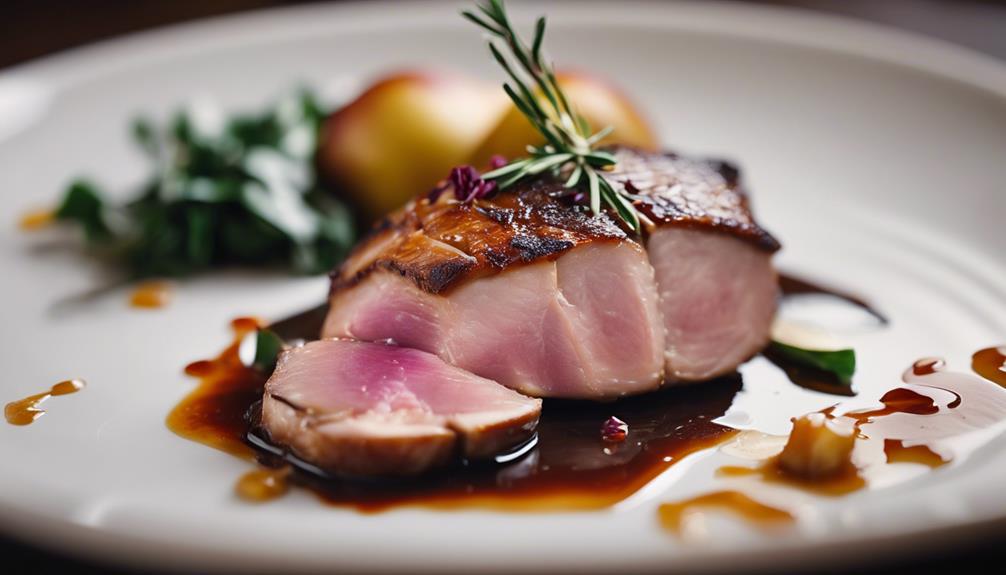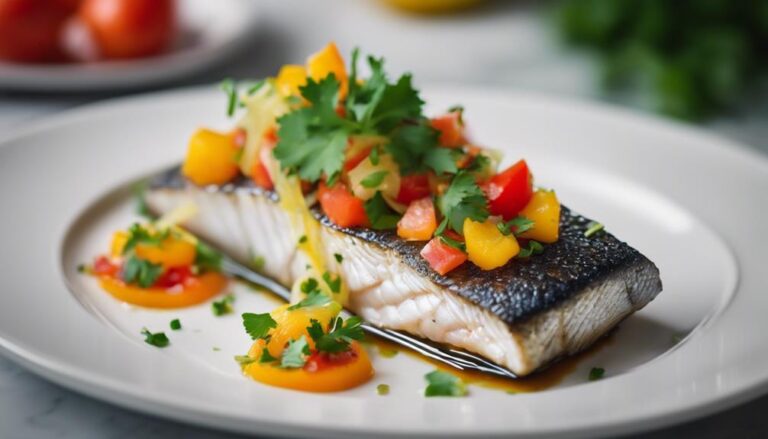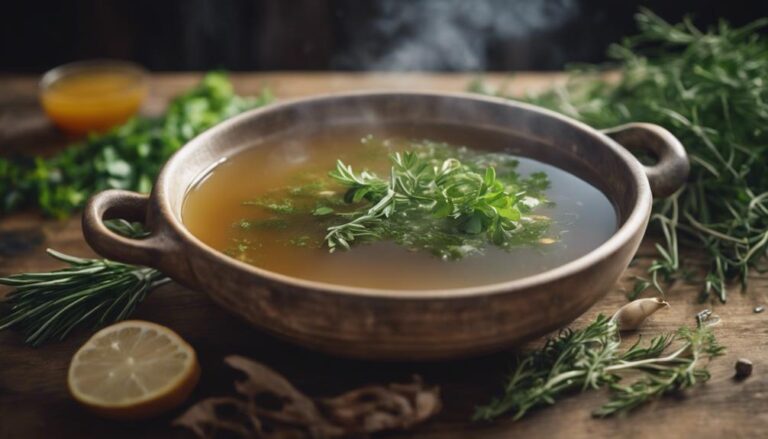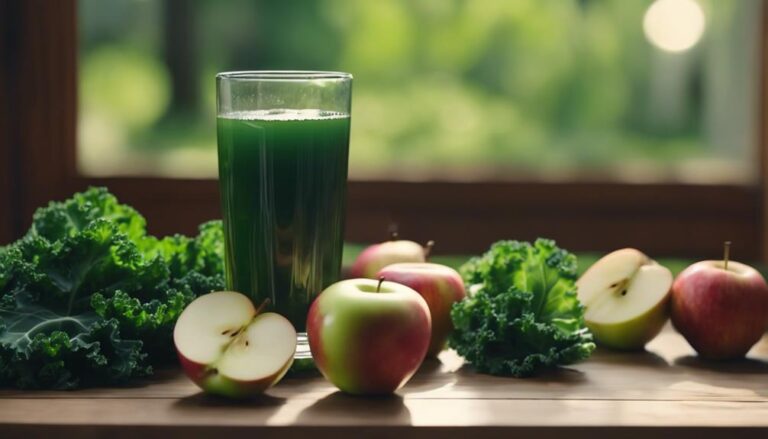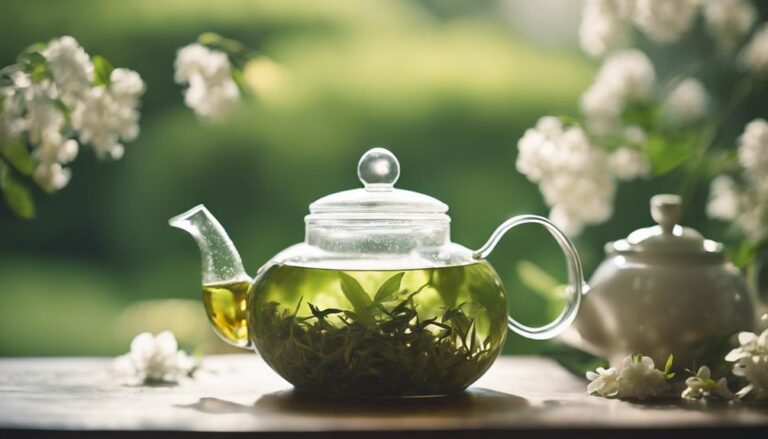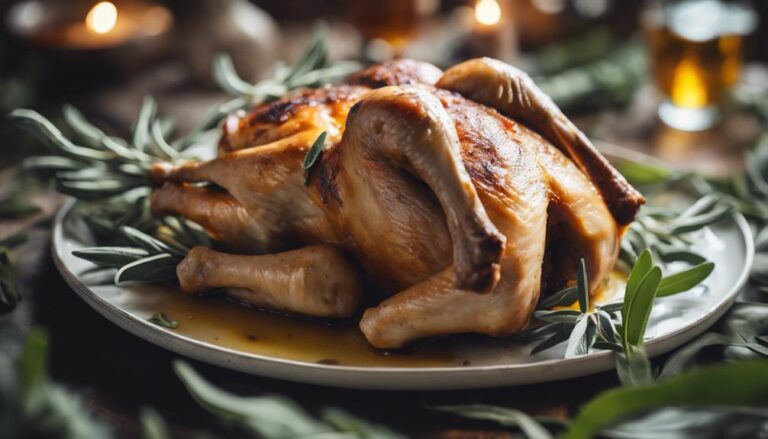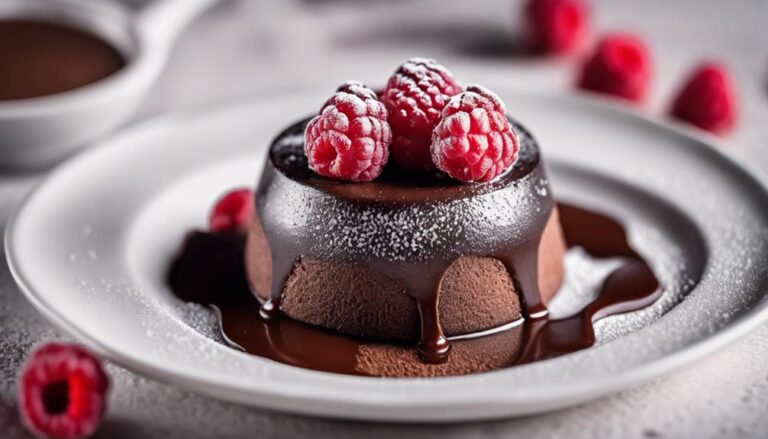Roasted Duck Breast With Sous Vide Pears
To create a delectable dish of roasted duck breast with sous vide pears, start by tenderizing the duck breast using the sous vide method. This technique guarantees a juicy texture by cooking the meat at a low temperature. Pair this succulent duck breast with delicately cooked sous vide pears for a harmonious blend of flavors and textures. Experiment with different marinades to enhance the taste profile, such as citrus zest, herbs, and honey. Achieve a golden brown crispy skin by patting dry, scoring, and seasoning before serving. Elevate your culinary experience with this exquisite dish that balances savory and sweet flavors effortlessly.
What You Will Learn Here
- Sous vide cooking ensures tender duck breast with precise temperature control.
- Roasting method for crispy skin and flavor development.
- Infusing pears with sous vide enhances taste and texture.
- Balancing savory duck with sweet pear for a unique dish.
- Perfect pairing of sous vide duck breast with juicy, flavorful pears.
Duck Breast Evolution
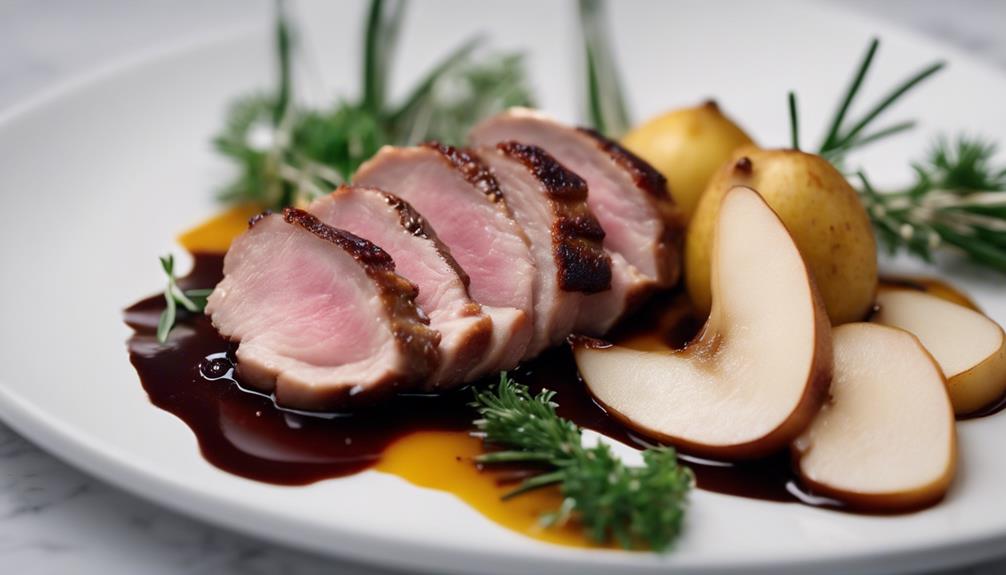
When considering the evolution of duck breast, it's important to focus on its tenderness, various flavor infusion techniques, and the comparison of cooking methods.
Understanding how to achieve the perfect tenderness in a duck breast can elevate your culinary experience.
Experimenting with different flavor infusion techniques can add depth and complexity to your dishes.
Duck Breast Tenderness
To enhance the tenderness of duck breast, chefs have been experimenting with various cooking techniques. One popular method is sous vide, known for its ability to lock in moisture and create a juicy texture in duck breast. When duck breast is cooked sous vide, it's vacuum-sealed in a bag and cooked in a precisely controlled water bath at a consistent low temperature. This gentle cooking process helps break down tough connective tissues, resulting in a tender and succulent final product.
The benefits of using sous vide for duck breast are twofold. To begin with, the low and steady cooking temperature ensures that the meat is cooked evenly from edge to edge, eliminating any risk of overcooking and maintaining excellent tenderness. Moreover, the sealed environment prevents moisture loss, preserving the natural juices of the duck breast and enhancing its juiciness.
Flavor Infusion Techniques
Experimenting with various flavor infusion techniques has led to an evolution in the way duck breast is prepared, elevating its culinary profile. One popular method is using a smoking technique to impart rich, smoky flavors into the meat. By exposing the duck breast to wood smoke during cooking, you can enhance its taste and aroma, creating a unique dining experience.
Another effective way to infuse flavors into duck breast is through brining. Brining benefits the meat by adding moisture and tenderness while allowing the flavors to penetrate deeply. Consider incorporating herbs, spices, and citrus fruits into your brine mixture to enhance the taste profile even further.
When it comes to seasoning tips, experimenting with different herbs and spices can help you discover exciting flavor combinations. Try using a blend of thyme, rosemary, and garlic for a classic taste, or explore more exotic options like star anise, ginger, and orange zest for a creative twist on traditional duck dishes. By mastering these flavor infusion techniques, you can uncover a world of culinary possibilities with duck breast.
Cooking Method Comparison
Comparing different cooking methods for duck breast has played a significant role in its culinary evolution, enhancing both its texture and flavor profile. Temperature control is vital when cooking duck breast to achieve the desired level of doneness.
By using methods like sous vide, where the meat is vacuum-sealed and cooked in a precisely controlled water bath, you can guarantee that the duck breast reaches the ideal internal temperature without overcooking. This gentle cooking process helps retain the natural juices and flavors of the meat, resulting in a tender and succulent final dish.
Cooking time is another factor to take into account when choosing a method for preparing duck breast. Traditional methods like roasting or pan-searing require careful monitoring to prevent the meat from becoming tough and dry. In contrast, sous vide cooking allows for longer cooking times at lower temperatures, breaking down collagen gradually for a more tender outcome.
Experimenting with different cooking methods can help you discover the perfect balance of temperature control and cooking time to elevate the flavors of your roasted duck breast to new heights.
Duck Breast Marinade Essentials
Enhance the flavor of your roasted duck breast by incorporating essential marinade ingredients.
- Citrus Zest: Add a burst of freshness with lemon or orange zest to brighten up the rich duck flavor.
- Fresh Herbs: Infuse your marinade with thyme, rosemary, or sage for a savory and aromatic touch.
- Sweet Honey: Balance out the savory notes with a touch of honey for a hint of sweetness and caramelization.
When it comes to marinade secrets for duck breast, understanding flavor profiles is key. Citrus zest brings a tangy brightness that cuts through the richness of the duck, while fresh herbs add depth and complexity to the overall taste.
The sweetness of honey not only balances out the savory elements but also helps in achieving a beautifully caramelized exterior when roasting the duck breast. By combining these essential marinade ingredients, you can elevate your roasted duck breast to a whole new level of flavor perfection.
Top Duck Breast Recipes
When it comes to creating delicious duck breast dishes, you have some fantastic options to explore.
Try making Sous Vide Duck Breast for a perfectly cooked and tender meal.
For a unique twist, consider whipping up a Pear-Infused Duck Breast that combines savory and sweet flavors.
Looking for a more intricate dish? Give the Duck Breast Roulade Recipe a go for a culinary masterpiece that will impress your guests.
Sous Vide Duck Breast
For perfectly cooked duck breast every time, consider trying the sous vide method, a favorite among top duck breast recipes. Sous vide offers precise temperature control, ensuring your duck breast is cooked to perfection without the risk of overcooking. Here are some benefits of using sous vide for duck breast cooking:
- Tender Texture: Sous vide cooking allows the duck breast to cook gently and evenly, resulting in a tender and juicy texture that's hard to achieve with traditional methods.
- Enhanced Flavor: By vacuum-sealing the duck breast with seasonings before cooking sous vide, the flavors are sealed in, creating a more intense and well-rounded taste.
- Consistent Results: With sous vide, you can replicate the same delicious results every time you cook duck breast, making it a reliable method for home cooks and professionals alike.
Mastering the sous vide technique for duck breast will elevate your culinary skills and impress your guests with perfectly cooked, flavorful meat.
Pear-Infused Duck Breast
To infuse your duck breast with a delightful twist, consider incorporating the sweet and aromatic flavors of pears in this top duck breast recipe. When preparing this pear-infused duck breast, keep in mind the importance of cooking precision to achieve a perfectly balanced and flavorful pairing.
Here are three key tips to enhance your cooking experience:
- Select Ripe Pears: Choose ripe pears for maximum sweetness and flavor infusion into the duck breast.
- Marinate Adequately: Allow the duck breast to marinate with the pear mixture for best taste and tenderness.
- Monitor Cooking Time: Maintain cooking precision by monitoring the duck breast's cooking time to make sure it's perfectly cooked and infused with the delicious pear essence.
Duck Breast Roulade Recipe
Indulge in the delectable flavors of our Duck Breast Roulade Recipe, an excellent addition to your culinary repertoire. This recipe combines the rich taste of duck breast with a touch of sophistication, making it a perfect choice for your next special occasion.
Here are three reasons why you should try this mouthwatering dish:
- Duck Breast Brining: By brining the duck breast before cooking, you enhance its flavor and tenderness, ensuring a juicy and succulent final result.
- Sous Vide Perfection: Utilizing sous vide cooking guarantees precise temperature control, allowing the duck breast to cook evenly and retain its natural juices for a melt-in-your-mouth experience.
- Impressive Presentation: Rolling the duck breast into a roulade not only elevates the dish aesthetically but also creates a delightful texture contrast with each bite.
Don't miss the opportunity to impress your guests with this Duck Breast Roulade Recipe that perfectly balances simplicity and sophistication.
Crispy Skin Technique
To achieve a perfectly crispy skin on your duck breast, you'll want to explore different skin crisping methods. This process is essential for achieving that desirable golden brown color that adds both texture and flavor to your dish.
Understanding the techniques involved will elevate the overall quality of your roasted duck breast.
Skin Crisping Methods
For achieving the perfect crispy skin on your duck breast, consider employing a two-step crisping technique. When it comes to skin browning, an important factor to keep in mind is moisture retention. To crisp the skin effectively, begin by patting the duck breast dry with paper towels. Removing excess moisture is essential for achieving that desired crispiness.
Next, to further enhance the skin browning process, you can lightly score the skin with a sharp knife. This helps the fat to render more efficiently, resulting in a crisper texture. Additionally, seasoning the skin with salt before cooking can draw out even more moisture, aiding in the crisping process.
Achieving Golden Brown
When aiming to achieve a golden brown crispy skin on your roasted duck breast, the moisture removal and scoring techniques previously discussed play an essential role in the crisping process. Browning techniques and temperature control are key factors in achieving that perfect crispiness. By ensuring the duck skin is dry before cooking and scoring the skin to help render the fat, you set the stage for a beautifully browned finish.
Caramelization secrets and the Maillard reaction are what bring that enticing golden hue to the skin of your duck breast. Controlling the cooking temperature is essential to allow these chemical processes to occur, creating that desirable crispy texture and deep flavor. The sugars in the skin caramelize, while the proteins undergo the Maillard reaction, resulting in a complex and delicious taste profile.
Texture and Flavor
To enhance the texture and flavor of your roasted duck breast, mastering the crispy skin technique is essential for achieving a delectable culinary experience. The crispy skin on the duck breast provides a delightful texture contrast to the tender meat inside. When perfectly executed, it offers a satisfying crunch that complements the juiciness of the meat, creating a mouthfeel exploration that elevates each bite. Additionally, the flavor pairing of the crispy skin with the succulent duck meat enhances the overall taste combination of the dish.
Achieving the perfect crispy skin involves careful rendering of the fat layer beneath the skin, leading to a golden brown finish. This process not only adds visual appeal to the dish but also contributes significantly to the overall taste and texture. The contrast between the crispy exterior and the moist interior of the duck breast tantalizes the palate, making each bite a harmonious blend of textures and flavors. Mastering the crispy skin technique will take your roasted duck breast to the next level, creating a culinary experience that's sure to impress.
Final Thoughts
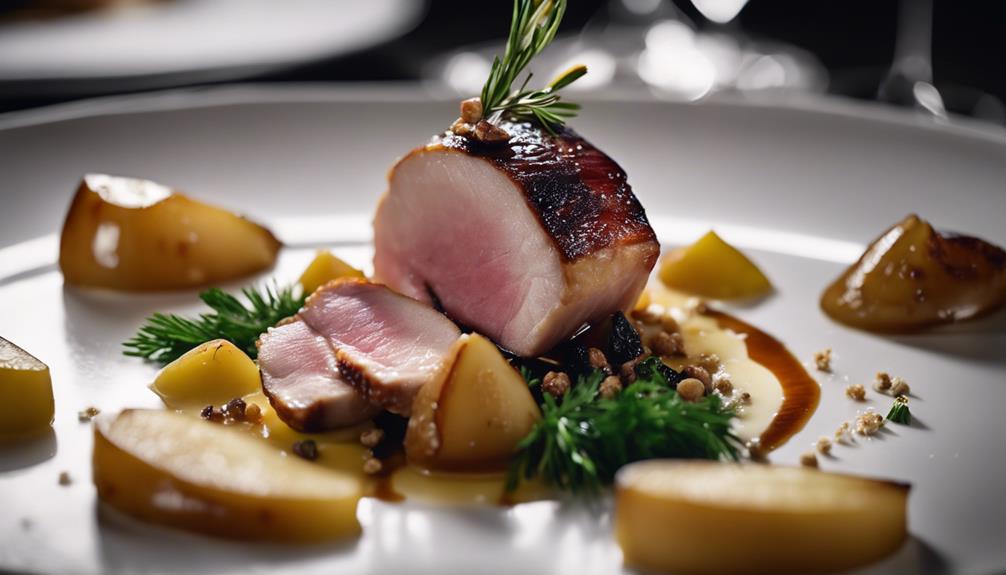
In conclusion, consider experimenting with different ingredient pairings to elevate the flavors of your roasted duck breast and sous vide pears. When it comes to wine pairings, opt for a medium-bodied red like Pinot Noir to complement the richness of the duck and the subtle sweetness of the pears. For plating presentation, think about adding a pop of color with a sprinkle of fresh herbs or a drizzle of balsamic reduction to enhance both the visual appeal and taste of the dish.
Exploring the benefits of sous vide cooking, remember that this method offers precise temperature control, ensuring your duck breast is perfectly cooked to your desired doneness. To achieve the best results, seal the duck breast with herbs and butter before cooking sous vide to infuse the meat with flavor. Additionally, searing the duck breast after sous vide can help create a crispy skin while locking in the juices.
Frequently Asked Questions
Can I Use a Different Type of Fruit With the Roasted Duck Breast?
Yes, you can definitely use a different type of fruit with the roasted duck breast. Consider grilled peaches or baked apples for a sweet touch. Poached figs or caramelized pineapple can also complement the dish beautifully. Experiment and enjoy!
Is It Possible to Sous Vide the Duck Breast Without a Vacuum Sealer?
Yes, you can sous vide the duck breast without a vacuum sealer. Try using the water displacement method or ziplock bags for sealing. These are effective sous vide alternatives that work well for home cooks.
How Can I Adjust the Cooking Time for a Larger Duck Breast?
To adjust the cooking time for a larger duck breast, you can increase the sous vide temperature slightly and add extra time. If you lack a vacuum sealer, try using a resealable bag and the water displacement method for sous vide alternatives.
Can I Substitute the Duck Breast With Another Protein in the Recipe?
Yes, you can substitute the duck breast with various vegetarian options or meat alternatives to accommodate dietary restrictions. Adjust recipe modifications accordingly for a similar flavor profile. Explore options like portobello mushrooms, seitan, or tofu.
What Are Some Creative Ways to Use Leftover Roasted Duck Breast?
When you have leftover roasted duck breast, get creative! Try making duck tacos or a flavorful duck salad. You could also whip up a delicious duck pasta or a quick duck stir fry for a tasty meal.
Conclusion
To sum up, roasted duck breast with sous vide pears is a delectable and elegant dish that combines tender, flavorful duck with sweet, juicy pears.
The marinade is crucial for enhancing the natural richness of the duck meat, while the crispy skin technique adds a satisfying crunch to each bite.
Whether you're a seasoned chef or a novice in the kitchen, this dish is certain to impress your guests and elevate your culinary skills.
Give it a try for a memorable dining experience.
